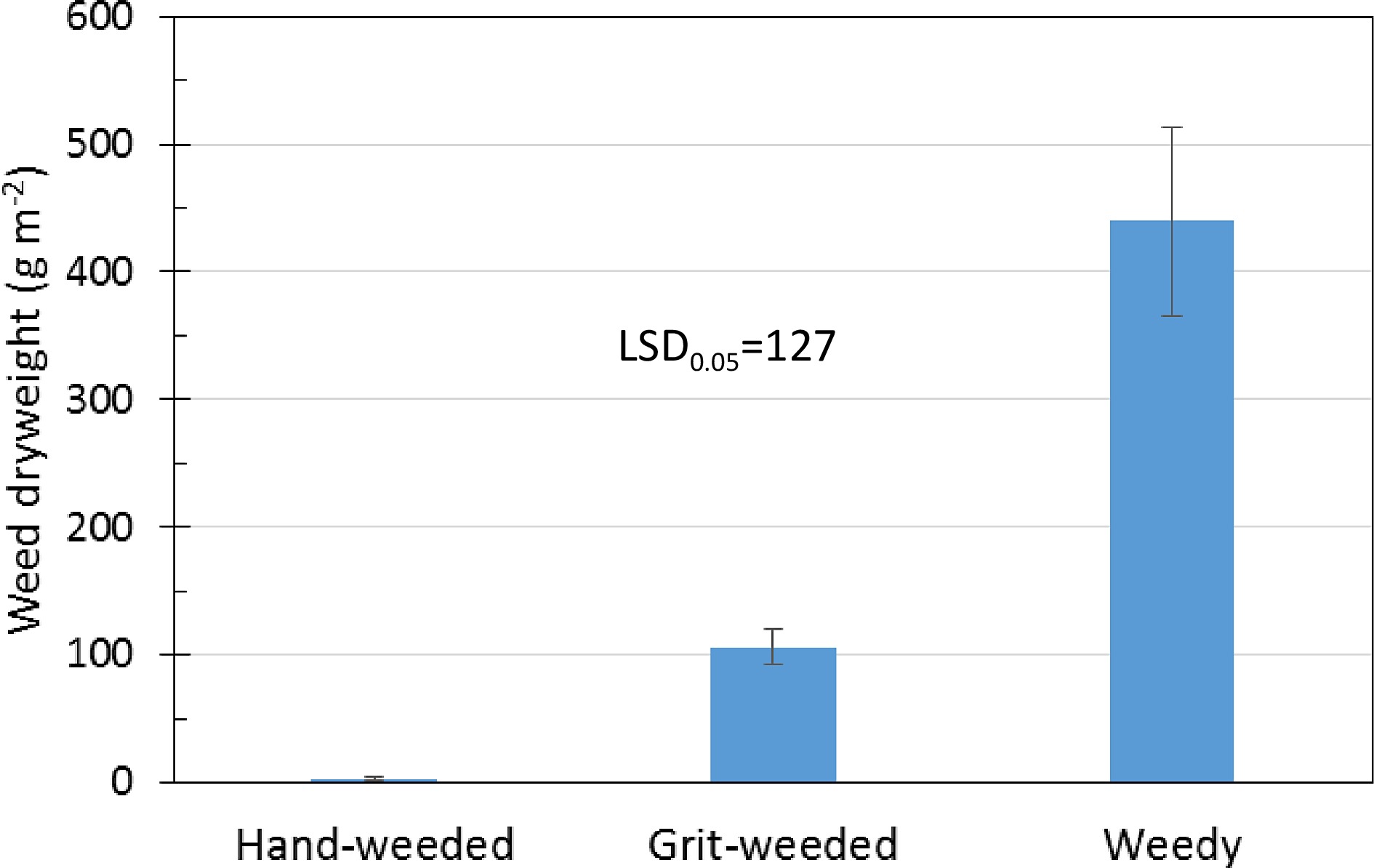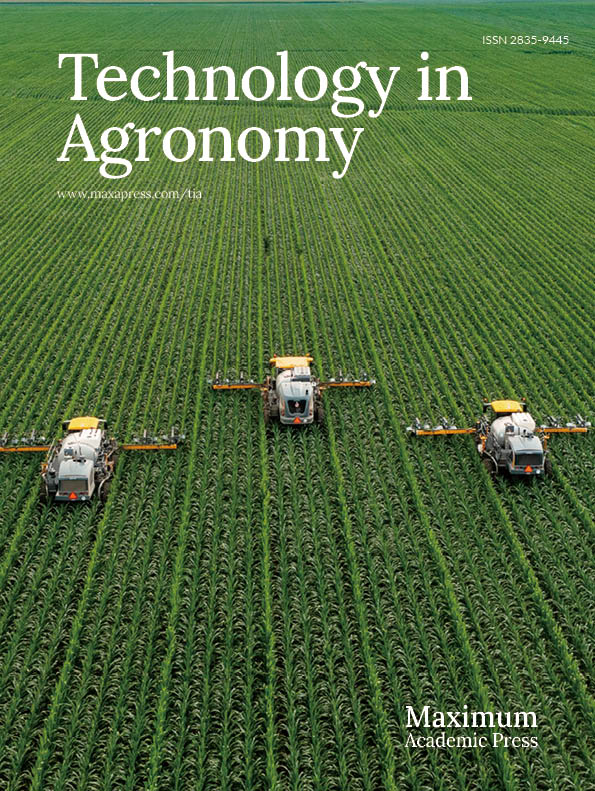-
About two square meters of weed-free space are required for optimal growth and production of a dwarf tree in modern, short-statured, apple orchards[1]. Weed-free space is needed to eliminate weed interference with the tree, as well as to reduce habitat for tree-damaging rodents and other pests[2]. A wide variety of herbicides are labeled for use in apple to create desired weed-free zones amongst apples trees[3]. However, some growers prefer to minimize herbicide use in favor of non-chemical weed control tactics.
A number of non-chemical tactics are available for growers, such as flaming, mowing, mulching, and tilling, and each can achieve a high level of weed control in certain situations. Unfortunately, each tactic also has limitations in terms of weed control and/or interference with other management problems[2]. For instance, flaming can damage trees and requires considerable use of propane, mowing results in only short-term weed suppression and usually needs to be repeated, mulching creates habitat for rodents[4], and tillage can damage apple root systems[5].
These important limitations suggest that the weed control arsenal requires supplementation with additional tactics. A new technique for postemergence control of weed seedlings is known as grit-weeding. With this technique, abrasive grit derived from soil (e.g., quartz sand) or agricultural residues (e.g., grape pomace, olive pits, nut shells) is discharged under high air pressure to abrade and kill weed seedlings[6]. With proper aiming, timing, and application rates, abrasive grits can suppress weeds and leave crops unscathed[7]. To date, abrasive grits have been tested successfully for selective control only in annual crops. Recently, this new technique was attempted in transplanted red raspberry (Rubus idaeus) during the cane establishment phase[8]. It has never been tested in established perennial crops. The goal of the current research was to examine the efficacy of grit-weeding in an established apple orchard.
-
Experiments were conducted in 2018 and 2019 at the Fairhaven Farm, Stearns County, MN, USA (45.323868, −94.216608), which is a privately owned commercial farm emphasizing a wide variety of traditional and exotic horticultural crops that can be grown in the region. Soil type was an Arvilla sandy loam (sandy, mixed, frigid Calcic Hapludoll).
The experimental area was a section of the orchard with tree rows separated by 4 m. Grass alleys (2.8 m wide) occurred between adjacent rows. Trees were planted in 2012 with 'First Kiss' apple on 'V.1' rootstock. Planting arrangement was an open Tatura trellis system, which consisted of twin rows (sub rows) of staggered trees. Sub rows were separated by 0.6 m, and trees within a sub row were spaced at 1.0 m intervals. Each tree was pruned in a dual-leader (Y-shaped) manner. Tree height each spring (after pruning) was about 2 m. The row floor was covered by a wood chip mulch (1.2 m wide).
A plot consisted of four trees; i.e., one set of two trees in each of the adjacent sub rows. Thus, each plot had the shape of a parallelogram, with a width and length of 1.2 m × 2.0 m. Each sub row was fitted with a drip irrigation line, and the entire experimental area was irrigated when necessary and otherwise managed as a commercial crop by the cooperating grower.
Three treatments were implemented: weedy check, hand-weeded, and grit-weeded. Plots were arranged in a randomized block design with four replications. In the weedy check treatment, weeds grew unimpeded from early spring until late July. Weeds in the hand-weeded treatment were hoed manually or pulled by hand semi-weekly to biweekly beginning in May until July. The hand-weeded expanse consisted of the entire parallelogram bounded by the four trees plus a 30-cm border surrounding that area. Time spent hand-weeding was recorded with stop watches.
Grit-weeding consisted of applying commercially available corn-cob grit at 700 kPa using a portable, wagon-mounted, single nozzle grit applicator as pictured in[9]. Grit particles were about 0.5 mm diameter and had a specific gravity of 0.43 ± 0.005 g·ml−1; these characteristics matched grits used by others[7]. The nozzle of the grit applicator typically was positioned 30 cm from the target weeds. The grit-weeded expanse consisted of the entire parallelogram bounded by the four trees plus a 30-cm border surrounding that area. Time spent applying grit and the amount of grit applied in each plot were recorded. Dates of grit weeding were identical to those of hand-weeding.
Weeds within quadrats were harvested by clipping at ground-level in late July. Quadrats were 0.1 m2 and were centered on each tree in each plot. Weeds were sorted into two groups: grasses and broadleaf plants. Dry weights of weeds were recorded after drying at 60 °C for one week. Lengths of new growth on the longest leader shoot of each tree was recorded in late August each year. All data were tested for homogeneity of variances, and treatment means were separated through ANOVA and LSD with alpha levels of 0.05, as well as t-tests.
-
Patterns of weed growth among treatments were similar each year (P = 0.36) and, therefore data were combined across years (Fig. 1). Effects of weed control treatments were highly significant (P < 0.01). In the absence of weed control, weeds attained an average dry weight 440 g·m−2 by July each year, when emergence of new weeds largely ceased. July also is the end of the critical period of competition between weeds and apple[1, 10, 11]. Broadleaf weeds were most common, representing about 80% of total weed biomass. Hand-hoeing and hand-pulling nearly eliminated weeds, as expected, to only 3 g·m−2. Application of grit decreased weed biomass to 106 g·m−2 (i.e., 76% weed control), which did not differ significantly from the hand-hoed treatment (LSD = 123).

Figure 1.
Weed dry weights (mean ± s.e.) as affected by three weed control treatments in late July in an apple orchard over two years
(2018 and 2019). LSD = least significant difference (P = 0.05). Broadleaf weeds were controlled with grit much better than grass weeds (e.g., about 90% vs 15%), as was also observed in red raspberry[8]. The most common broadleaf weeds in these experiments were annuals, such as common lambsquarters, mallow, fleabane, redroot pigweed, Pennsylvania smartweed, and wild buckwheat (Chenopodium album, Malva spp., Conyza canadensis, Amaranthus retroflexus, Polygonum pensylvanicum, and P. convolvulus, respectively); but perennials were also common, including dandelion, field bindweed, and Siberian elm (Taraxicum officinale, Convovulus arvensis, and Ulmus siberica). Weedy grasses were comprised of annuals, for example barnyardgrass, crabgrass, and foxtail (Echinochloa crus-galli, Digitaria spp., and Setaria spp.), as well as perennials, especially bluegrass, smooth brome, and quackgrass (Poa pratensis, Bromus inermis, and Elytrigia repens). Control of perennial weeds is especially important in a perennial crop. Good control of perennial broadleaf weeds was encouraging in these experiments, but poor control of perennial grass weeds is a concern for this new system of weed management.
Growth of apple leader shoots was not influenced significantly by weed management in either year according to ANOVA (P > 0.20) (Fig. 2). However, in 2019 t-tests between individual treatments suggested that grit-weeding may have increased leader shoot growth compared to hand-hoeing (P = 0.07) and the weedy check (P = 0.10), whereas there was no apparent difference between these latter two treatments (P = 0.23). Presumably, weeds suppressed apple shoot growth in the weedy control plots, and disruption of apple roots in surface soils may have inhibited shoot growth in the hand-hoed plots. Grit applications suppressed most weeds but did not disrupt the soil and, therefore, possibly allowed better growth of apple leader shoots. Similarly, tree roots are known to be damaged by mechanical fallow (analogous to hand-hoeing) and when under cover crops (analogous to weeds), but not by herbicide fallow[5, 12].

Figure 2.
Annual growth (mean ± s.e.) of longest leader shoot of apple as affected by three weed management treatments. Slashed bars, 2018; solid bars, 2019.
The number of weeding events from May through July averaged 11 to 13 per season. Whether fewer events could have resulted in similar levels of weed control and apple growth is unknown for grit-weeding, which is a newly developed control tactic. Cumulative season-long time spent grit-weeding was appreciably greater than that for hand-hoeing (Table 1). Much of this time was devoted to abrading or at least suppressing grass weeds, especially the perennial grasses, which appeared appreciably resistant to abrasion with corncob grit. Harder and more abrasive grits derived from sand or nut shells[6] may be more effective on perennial grasses than relatively soft corncob grit. More grit was used in 2018 than 2019, primarily because of the greater weed growth in the former year. Not surprisingly, the amount of grit applied was associated with the time spent grit-weeding, averaging 0.27 kg min−1 of grit application.
Table 1. Number of weeding events, time spent weeding, and amounts of grit applied during experiments conducted over two years. Values for times and grit amounts represent cumulative means ± standard errors per m2 of plot area.
Years Treatments Hand-weeded Grit-weeded Events Time (min) Events Time (min) Grit (kg) 2018 11 ± 0 7.0 ± 0.38 11 ± 0 17.6 ± 0.50 4.6 ± 0.11 2019 13 ± 0 5.0 ± 0.74 12 ± 0 6.9 ± 0.70 1.9 ± 0.20 -
Grit-weeding is not a panacea for weed management. It represents a new tactic for weed control in perennial cropping systems that can be added to the arsenal of tactics employed by growers. It is particularly effective for controlling broadleaf weeds, but lacks efficacy for grass weeds, especially perennial grasses. Corncob grit is a soft grit typically employed for abrading grime from machinery, etc., where hard grits cannot be used safely. Corncob grit was used in these experiments because of its availability in the Upper Midwest (USA) and because it represents an under-used agricultural residue. To control grass weeds through abrasion, the use of harder grits may be necessary. These grits also can be agricultural residues, such as walnut shells, livestock bone meal, or even quartz-type sands, which could be extracted cheaply from growers’ own fields.
Research was funded by the Specialty Crop Block Grant Program of USDA-NIFA through the Minnesota Department of Agriculture.
-
The authors declare that they have no conflict of interest.
- Copyright: © 2023 by the author(s). Published by Maximum Academic Press, Fayetteville, GA. This article is an open access article distributed under Creative Commons Attribution License (CC BY 4.0), visit https://creativecommons.org/licenses/by/4.0/.
-
About this article
Cite this article
Forcella F, Poppe S, Hoover E. 2023. Abrasive grit-weeding in apple. Technology in Agronomy 3:1 doi: 10.48130/TIA-2023-0001
Abrasive grit-weeding in apple
- Received: 01 November 2022
- Accepted: 12 December 2022
- Published online: 17 January 2023
Abstract: New forms of weed control may be useful in apple orchards. Abrasive corn cob grit applied under high air pressure was tested for the control of weeds in an established apple orchard over two years. Additionally, efficacy of abrasive grit-weeding was compared to that of hand-weeding. As expected, hand-weeding nearly eliminated all weeds. In contrast, grit-weeding achieved about 90% control of broadleaf weeds, only 15% control of grass weeds, and 70 to 80% control of all weeds. Much of the time and amount of grit used was devoted to suppressing grass weeds. Relatively soft corn cob grit easily abraded and controlled broadleaf weeds. However, harder and more angular grit materials may be needed to control annual and perennial grasses.
-
Key words:
- Weeds /
- Control /
- Grit-weeding /
- Grit /
- Abrasive /
- Malus domestica /
- Physical control












